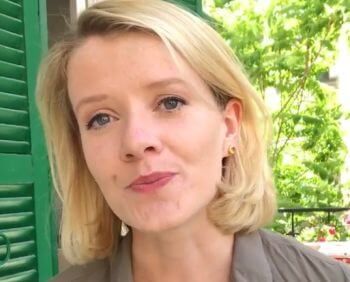For more than a year, Palestinians have violently clashed with Israeli soldiers guarding the Gaza border.
The clashes first erupted in March, 2018, originally spun by the Palestinians as a peaceful “March of Return.” The Myths and Facts of Gaza’s Deadly ‘Protests’ laid bare that the spontaneous, peaceful protests were anything but. Facing popular dissent, Hamas co-opted the March of Return movement to make sure it would generate Palestinian casualties — and sympathetic media coverage.
Hamas’s primary goal: News reports humanizing Palestinian victims, and/or painting Israeli soldiers as indiscriminate war criminals. For that, Hamas needed civilian cannon fodder and reporters willing to follow their narrative.
That brings us to PBS NewsHour, whose correspondent, Jane Ferguson, filed a dispatch about Palestinians left handicapped by IDF fire. Humanizing disabled Palestinians without explaining Hamas’s responsibility plays into the terror group’s hands. And the Islamists couldn’t have asked for a better dispatch than Ferguson’s.
The ‘split screen’ clash
Ferguson’s first introduces us to Ahmed Abu Nair. He lost a leg to a gunshot wound at the border, and now he plays soccer on crutches along with other handicapped Gazans. Ferguson explains he was injured on May 14, the day the US opened its embassy in Jerusalem.

Prior to May 14, the border violence was related to the “March of Return.” But former Associated Press correspondent Matti Friedman explains how a “split screen” effect changed perceptions that day. The split screen he refers to is coverage of the embassy opening appearing side by side with the clashes on peoples’ televisions.
The attempts to breach the Gaza fence, which Palestinians call the March of Return, began in March and have the stated goal of erasing the border as a step toward erasing Israel. A central organizer, the Hamas leader Yehya Sinwar, exhorted participants on camera in Arabic to “tear out the hearts” of Israelis. But on Monday the enterprise was rebranded as a protest against the embassy opening, with which it was meticulously timed to coincide. The split screen, and the idea that people were dying in Gaza because of Donald Trump, was what Hamas was looking for.
The press coverage on Monday was a major Hamas success in a war whose battlefield isn’t really Gaza, but the brains of foreign audiences.
Foreign audiences like the millions of people who watch NewsHour.
Related reading: The Gaza Blockade: An Explainer
The doctor
NewsHour also introduces us to Dr. Adnan al Borsh, who treated many Palestinians injured that day. He’s disturbed that so many Palestinians were all shot in the leg, and that the bullets did a lot of damage to bones, blood vessels and nerves.
But Ferguson misses the obvious point.
IDF sharpshooters aimed at peoples’ legs because they were not shooting to kill.
Dr. Borsh’s talk of bullets, damage, and entry points are a red herring. Israel faced thousands of Palestinians violently seeking to breach the border. Yet PBS NewHour gives a platform to doctor whose implies that Israeli soldiers are war criminals because they’re not equipped with magic bullets capable of dispersing rioters without causing unpleasant damage.
Related reading: Debunking the Disproportionate Force’ Charge
”The most cynical here’
 A big problem with the NewsHour dispatch is that there are no Israeli voices. To be fair, Ferguson says she sought to talk to the IDF but all they provided was a short statement which the video notes. She also refers to an old quote by Prime Minister Benjamin Netanyahu rejecting the findings of a UN inquiry.
A big problem with the NewsHour dispatch is that there are no Israeli voices. To be fair, Ferguson says she sought to talk to the IDF but all they provided was a short statement which the video notes. She also refers to an old quote by Prime Minister Benjamin Netanyahu rejecting the findings of a UN inquiry.
But that doesn’t mean NewsHour is off the hook for the lack of balance. This was not a 90-second update, this was a 10-minute dispatch. The time invested to line up interviews with disabled Palestinians, a doctor, and officials from Amnesty International as well as Doctors Without Borders isn’t insignificant. NewsHour is better than that.
- Were there no Israeli experts available to provide fresh quotes to a PBS reporter?
- Was her query to the IDF merely going through the motions
- Would an Israeli point of view ruined the arc of her story?
Related reading: Defining Bias: Lack of Context
Towards the end, Ferguson makes a small, but telling observation, perhaps oblivious to its importance, or maybe taking a half-hearted stab at even-handedness:
The most cynical here encourage the smallest to approach the fence, goading Israel guards.
Who exactly are these “most cynical” Palestinians sending children to the border?
Could they be the same Palestinians who sent Ahmed Abu Nair and his soccer friends to be cannon fodder?
Please send your considered comments to the PBS Public Editor, Ricardo Sandoval-Palos.
Featured image: via YouTube/PBS NewsHour; Ferguson via YouTube/Pulitzer Center;
Before you comment on this article, please note our Comments Policy. Any comments deemed to be in breach of the policy will be removed at the editor’s discretion.

